
|   |

|   |
Mahagami Gurukul at Aurangabad - Dr. Sunil Kothari e-mail: sunilkothari1933@gmail.com Photos courtesy: Mahagami May 9, 2013 It was a sheer pleasure to visit Mahagami Gurukul at Aurangabad for four days beginning with the celebrations of the World Dance Day from 27th April. For the past five to six years, I was invited to Bangalore and other places for the World Dance Day celebrations. It is always very educative to visit other places in India to see the horizontal growth of classical dance, and dream places like Protima Bedi's Nrityagram at Bangalore, Ratan Thiyam's Chorus Repertory Theatre at Imphal, Veenapani Chawla's Adishakti institution at Puducherry, Chandralekha's Spaces at Chennai to name a few, make one aware of the work done quietly in other parts of India. It was during International Kathak festival at Chicago organized by Dr. Sinha few years ago that I happened to note Parwati Dutta and her Kathak performance. Her interest in pakhavaj and dhrupad drew my attention. That she was equally at home with Odissi and playing mardala, I did not know. She recalls that during our visit to Avignon Festival in South France, she had asked me few questions regarding 'parna riti' mentioned in my book on Kathak. That someone so young had carefully and diligently read my book had indeed impressed me a lot. She received training in Kathak under Birju Maharaj at Kathak Kendra and Odissi under Madhavi Mudgal and Guru Kelucharan Mohapatra. She performed quite extensively as a solo dancer and when Odiya poet and scholar Jiwan Pani was director of Kathak Kendra, she used to ask several questions about shastra, as her interest in researches was deep. She hailed from Bhopal and hence had exposure to great Dhrupad masters, Kathak of Raigarh durbar and cultural activities that took place in Bhopal. Moving to Delhi, the training and also witnessing dance performances, attending seminars and developing a holistic approach to art, helped her grow into an inquiring dancer, not content with only performances. Two years ago, I happened to see her production Sannidhi at Ananya Dance Festival at Purana Quila, organized by Sanjiv Bhargav. Previous day at India International Centre during the discussion Parwati explained with her co-dancers from different forms, how she had worked the concept using seven classical dance forms, retaining autonomy of each form, the harmony of music and created a collage which lingered long in one's memory. This year at Khajuraho Dance Festival in February, I got another opportunity to watch it again. The uncluttered choreography, the seamless manner in which each dancer performed and the way recorded music looked harmonious impressed me. The concept of Nirgeet based on Natyashastra and another on seven rivers was imaginative. Since I was able to watch it a second time, I was able to see the great deal of research that had gone into it and the teamwork left an indelible impression. Parwati asked me if I was free to attend a workshop/seminar on journalism she had planned in April around World Dance Day and visit Mahagami. I readily accepted it, having learnt a lot from senior dancers and her well-wishers about Mahagami institution which she heads as a director, imparting training in both Kathak and Odissi and has instituted various other initiatives. I was eager to see the work routine also. She informed me that there would be a two day dance festival in the evening as a part of World Dance Day celebrations and then two day workshop on writing on dance, inviting local journalists and editors of leading newspapers like Maharashtra Times, Lokamat, Sakal, and other Marathi language newspapers. I was in for a surprise when I reached just in time for the evening Bharatanatyam performance by Sucheta Chapekar. I was taken through the maze of architectural lay out to the open air theatre where Sucheta was presenting Maratha ruler Shahji's compositions when he was ruling over Tanjore. Her work under the guidance of Acharya Parvati Kumar was further developed by her by visiting Tanjore and studying under Kitappa Pillai. She was in great form defying her age and looked stunningly beautiful, explaining the songs and how she had gradually taken to Hindustani music for Bharatanatyam Margam, using pakhavaj, parans for sollus, mnemonic syllables and so on. Her favourite Pahile Krishna, how a gopi looked at Krishna in his several forms, child Krishna, navanitachora, Govardhandhari, Gitopadesha, asking Arjuna to fight, Krishna playing rasalila with gopis, the gopi full of joy seeing Krishna in such moments. The natya sangeet song in which a nayika after dressing asks her beloved how she looks, and the nayaka tells her something in her ears which embarrasses her, but she is pleased, the various bhavas of lajja were registered with great felicity on her face. She received support from Vasant Rao Deshpande for music. Her young disciple Yashoda also performed well carrying on Sucheta's legacy. Both looked confident, self assured, dignified and at once won over the audience, with dance number performed to the songs in Marathi, natya sangeet and with excellent technique. 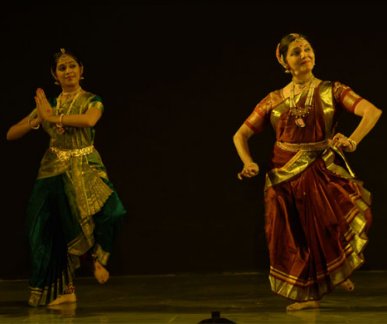 Yashoda & Sucheta Chapekar 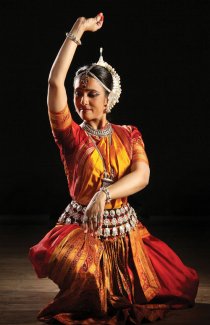 Parwati Dutta in Odissi solo The evening was made. The 350 strong audience was very responsive. Parwati's young colleague Vrishali Deshpande, who works for All India Radio, compered the show in clear diction, which was heartening as the entry points to the numbers performed were lucid and easy to follow. We all went for dinner at open air dining hall, where the young disciples served us dinner. It is a part of their training to look after guests and have administrative experience. The dining place reminded me of similar ones at Veenapani Chawla's and Nrityagram. More than that, the ambience was very pleasant and one could relax and talk at leisure. Early years Parwati came to Aurangabad 17 years ago. The trustees placed trust in her capacity as a teacher, performer and appreciated her vision for Gurukul. With grit and determination, Parwati started working round the clock, inspiring her shishyas and also people who helped her to build up the institution. Dance and music reviews were still published in newspapers and Parwati realized that she had to reach out to the people through print media. Not only that, she had to create awareness among the people about classical dance, even when there was quite an awareness about classical Hindustani music. In a freewheeling conversation before the seminar and workshop previous day I asked her to tell the story of Mahagami, her involvement and the heartwarming results achieved during past 17 years. It was not easy in the beginning. But slowly she could win the confidence of people with her performances and explanations. She developed great patience. She knew that in this land of Aurangzeb, who had a procession of tanpuras taken out and they were buried at a spot, to generate love for performing arts would not be an easy task. Also, it was this very land where the great Sarangadeva, though he was an auditor general in the court of the Yadav ruler Singhana, whose capital was Devagiri (the present Daulatabad off Aurangabad in South Maharashtra), had written Sangitaratnakara in 13th century. Both the Hindustani and Carnatic musicians regard it as a definitive text. Also known as Saptadhyayi, divided into seven chapters ,with first six chapters like svaradhyaya, ragavivekadhyaya, prakirnakadhyaya, prabandhadhyaya, taladhyaya, vadyadhyaya dealing with various aspects of music, the seventh nrityadhyaya deals with dance. (It has been translated by Radha Burnier and Alain Danielou for Theosophical Society, Adyar, Chennai). So Parwati decided to hold Sarangadev Samaroh with seminar and festival of dance and music. It was very well received. Mahagami invited scholars, gurus, musicologists, researchers to present papers, hold discussions and relate the text with performing arts. A galaxy of musicians and dancers including Ustad Amjad Ali Khan, Dhruba Ghosh, Uday Bhawalkar, Bahauddin Dagar, Ritwik Sanyal, N. Ramanathan, Vibhav Nageshkar, Umesh Moghe, Pandit Birju Mahraj, Rohini Bhate, Zia Fariduddin Dagar, Dr. Kanak Rele, Leela Samson, Madhavi Mudgal, Dr. Sandhya Purecha, Dr. Padma Subrahmanyam, Hari Prasad Chaurasia, G. Venu, Dr. Bharat Gupt, Pandit Suresh Talwalakar, Rani Karna, Ratikant Mohapatra, Pushparaj Koshti, Chetna Jyotish Beohar, were invited and honoured. Indeed this initiative has resulted into evolving academic and archival material of important musical wealth. Parwati is fond of Sanskrit and very consciously named some of the activities using Sanskrit terms which convey its implications and scope. Over the years more than 1,500 students have taken training at Mahagami. Parwati pioneered art awareness campaign Anubhuti and under it Mahagami has covered more than 1 lakh population. By presenting mainstream gurus, performers of different dance forms besides well-known four forms of Kathak, Bharatanatyam, Manipuri, Kathakali, she brought artistes from Odissi, Mohiniattam, Kuchipudi, Seraikella Chhau, Mayurbhanj Chhau, Koodiyattam, Sattriya dances. It was heartening to learn from her that she had approached Inspector General of Police, Jail Superintendent, leaders of corporate sectors, schools, colleges and succeeded in involving them with the dance activities. She performed for jails, police force, corporate houses and had good response. She worked out various strategies, including power point presentations, lec-dems, interactive sessions, discussions et al, leaving no stone unturned to generate interest in dance and music. 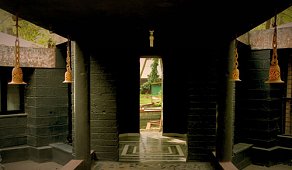
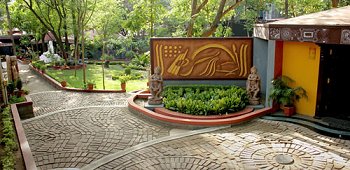
When I glanced through the literature on Mahagami Sangeet Academy (the acronym has been derived from Mahatma Gandhi Mission) I could see in what directions Parwati has succeeded in taking the institution which embraces various streams, not only of training in dance and music, but a welcome holistic approach which prepares a young disciple into a sensitive person, with exposure to allied arts, music, painting, sculpture, crafts, literature, research and fully developed personality. Parwati could have been a computer scientist, has good knowledge and is techno savvy; therefore, the aims of Gurukul have been well explained in the brochure. In Director's message, she has said: 'With a journey tracing two decades, Mahagami is a poised, articulate member of the global arts commune, has many performers, teachers and countless rasikas to its credit and I stand as a proud spectator of this remarkable growth eager to realize manifold existence of Mahagami, the sojourner.' The Gurukul offers training in Kathak, Odissi, Yoga, music, Sanskrit and visual arts. Its departments are named Praspanda for percussion instruments, Anahata for vocal music and melodic instruments, Vyomasad for dance. Courses offered are Arambha, Udbhav and Samarpana. Sadhana is Gurukula camp. I happened to be there when the camp opened. Nearly fifty young dancers, in some cases their elders also join for 15 days in summer from May 1 to May 15, training from morning 6am till 8pm daily. Residential facilities are given. Age limit is kept above ten and registration starts early in April. I could see that there was quite a rush. Aspirants had come from Bangalore, Mumbai, Pune and there were some outstation students. Anushthan - programs for dissemination and promotion of arts for art seekers. Under that in Parampara, demonstrations by senior gurus, performers are arranged. In Vistar, choreographic works are shown. Mahagami has also started Kalasnehi annual rasik membership. There are sections for creation, research, transcription, translations, publication of text books, availability of informative CDs, DVDs and website on arts. What I enjoyed most was learning about Gurukul experience: early morning herbal tea, yoga session, sessions on music and dance, nourishing breakfast and lunch. Evening sessions included demonstrations and short programs by Mahagami artistes. There is also provision for revitalizing and rejuvenating sessions at their Naturopathy centre. One can visit the textile weaving or painting section during their stay. Mahagami arranges for the bookings of Gurukul experience. Nritya Disha: Seminar, workshop on writing on dance 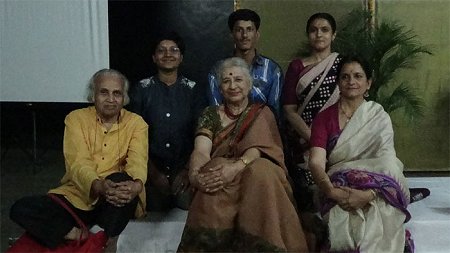 From left, standing: Shamal Ingle, journalist, Parwati Dutta Seated: Dr. Sunil Kothari, Leela Venkataraman, Prakriti Kashyap For the seminar from Delhi, the other two veteran scholars and critics were Leela Venkataraman, who writes for The Hindu every Friday, and Manjari Sinha, who writes for the Hindi newspapers and also occasionally for The Hindu. Others were from Mumbai - Prakriti Kashyap, a Bharatanatyam dancer, also specialized in masked Seraikella Chhau dances, with MFA in Dance from Nalanda Nritya Kala Mahavidyalaya with Sattvikabhinaya topic, and wrote as a dance critic for The Times of India and Ranjana Dave, an Odissi exponent, a freelance journalist, working for online journalism.  Pt Birju Maharaj at Mahagami
We began with introducing our journey, how we took to writing on dance and music and even when the space in newspapers is shrinking, we continue with our passion. What one should watch in dance and listen in music, what are the basics one should know, the need for knowing Sanskrit language, exposure to other allied arts like painting, sculpture, watching dance, attending music programs were all emphasized. There are no schools for critics. One learns as one goes along. Nowadays there are several books on dance and music available, which upcoming dance and music critics can read and learn about these arts. Also interacting with the artistes, making notes, asking questions, and having a passion to write, good command over language etc., were mentioned by most of us. We also explained that when one reads reviews and captions, headlines, they are not written by critics. The sub-editor edits the copy. When a critic is established, his copy (text) is not much edited. So many misconceptions were cleared. How a page is made up, how text is sometimes edited, who are sent to cover the cultural events. The paucity of trained personnel, a person who has to report about crime beat, often is asked to go and write about dance or music. And since he is not expert he makes general observations. Sometimes, sports reporters are asked to review art events. And the difficulties editors face are also numerous. There is no guarantee for income if one specializes in this area. Even then, arts are part of life and must be covered. Critics have to offer constructive criticism. They are watch dogs and not blood hounds. They have to be sympathetic in their assessment and writing. Since we seniors had more experience, we wanted young writers to speak. Prakriti Kashyap spoke about her experiences as a young critic and a dancer writing on dance, and consequent pain, injustice, misunderstandings, challenges one has to face etc. Ranjana Dave spoke about change in writing on dance. What young people would like to read, not only intimidating criticism, but stories about dancers, dance situation, economics etc. She said that one can, without diluting the standards, write on all these topics. Also write for electronic media, on line, and other media which offer space, blogs and so on. For an exercise, I screened a Films Division documentary on Bharatanatyam dancer Kamala (Laxman). Three young journalists wrote small pieces next day on what was discussed, their impressions. Shamal Ingle summarized experiences of senior critics. Prasenjit Gaekwad besides being a journalist directs films. So he wrote on documentary on Kamala. The female journalist summed up her understanding based upon our talks. It was indeed heartening to read their responses. Their sincerity was transparent and enthusiasm praiseworthy. The young journalists asked many questions about how to improve writing on dance. They interviewed us, made notes and hoped that they could continue to take interest in dance and write, watch performances, attend Mahagami events, visit library, read books and enrich themselves. Manjari Sinha laid stress on timeless civilization and culture of India and its value. Since Aurangabad newspapers and editors in particular, are keen on having informed and correct reporting on performing arts, such workshops and seminars would go a long way in achieving the goal. Sucheta Chapekar had informed that in October at Pune they would like to organize similar seminar workshop for young journalists to help them write on performing arts. Thus, in Maharashtra this awareness shall go a long way in having arts covered with appreciation. In most English newspapers, barring The Hindu, reviews are not published. In a way, it is systematic killing of institution of criticism, be it dance, music, painting, sculpture, or literature. One does not know when the barons of newspapers would restore criticism in their papers. Performances: 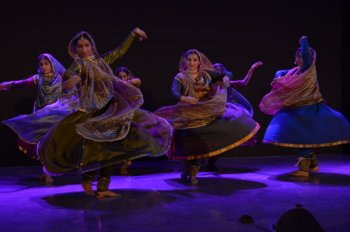 Parwati Dutta's group present Kathak
In Tarana in Kirwani of Birju Mahraj woven with tukde, tihai, ladi, chain of tihai, parans of fast tempo ending with tatkar and on tad ha with eka pada bhramari, she revealed the beauty of Kathak, where there was not just emphasis on bhramaris, pirouettes, chakkars only. In one of the innovative compositions of hers, she mentioned about how Birju Maharaj had taught her one paran with syllable dha, she had requested him to elaborate it. Maharaj-ji had used dha interpreting as Dhyan and on word Din interpreting it in many ways, how abstract mnemonics can be invested with meaning, the exploration becoming fascinating. There could be symbolism in abstract words. Parwati had mentioned about 'parna riti' reference in my book. I could see how she was further exploring it. After seeing her one presentation using Dha, Maharaj- ji told her that from a small seed planted somewhere, Parwati had seen to it growing into a tree. Her introductions to each number were thus very helpful to appreciate her approach and see how it is different from routine Kathak. Using poetry in Kathak she presented in a group number, Tulasi Das composition describing Basant in which the poet employs simile that Parvati came to see Lord Shiva in form of Basant. The description of Parvati, the words used by Tulasi Das are imaginative. The ankle bells Parvati has are made up of sounds of birds, her ornaments are of flowers, the gait is that of swan and so on. That sort of presentation was very captivating and stood out for her approach, explorations not only in music abut also in literature. She mentioned khule hath ka baz for use of percussion instrument. I enjoyed this face of Kathak, where emphasis was, as I have mentioned earlier, not only on virtuosity. 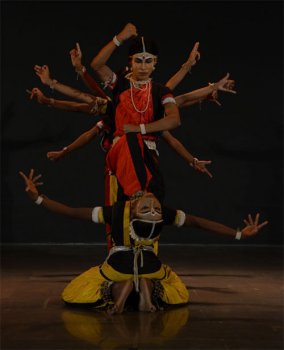 Nakshatra Gotipua dance troupe
The emphasis was on Bandha nritya, which incorporates yogic and acrobatic feats, forming various formations, pyramid like, dancers standing on each other, taking pose of Lord Shiva or Krishna and dissolving them in a trice. The tallest boy was in the centre and others were in ascending and descending heights. Often the lighting created interesting visuals. The audience indeed was thrilled to see such breathtaking display by young dancers. Having seen Gotipua dancers for many years, my interest was more in their rendering abhinaya to the songs. The leader of the troupe said that they did not come with songs as the demand generally is for acrobatic feats. However, on my request, they rendered a duet 'Dekho Radha Madhav chali', describing different musical instruments being played, presence of five gods, rendering of various melodies, the yugal swaroop of Radha and Krishna, the poet Banamali watching this sings praise of the divine pair. They concluded their performance with various bandhas like Sagadia, Gangavatarana, mayur, chala mayur, rolling on the floor, falling backwards and getting up without any apparent fatigue. The mnemonics 'tam thai takit tam thai' resonated with their seamless dancing. No wonder, as usual the cute young child -like dancers steal the show with their uninhibited dancing. On this occasion of World Dance Day Mahagami honoured few associates, painters, photographers, light designers, and compere Vrishali Deshpande, who have been part of Mahagami family. Leela Venkataraman, Manjari Sinha and I indeed enjoyed being with all at Mahagami and staying there in a Tapovan like place, with trees, open spaces, and knowing the praiseworthy work Parwati Dutta is doing there far away from the madding crowd in a quiet and peaceful manner. Here is to wish her great success to achieve her goals.  Dr. Sunil Kothari is a dance historian, scholar, author and a renowned dance critic. He is Vice President of World Dance Alliance Asia Pacific India chapter, based in New Delhi. He is honored by the President of India with Padma Shri, Sangeet Natak Akademi award and Senior Critic Award from Dance Critics Association, NYC. He is a regular contributor to www.narthaki.com, the roving critic for monthly magazine Sruti and is a contributing editor of Nartanam for the past 12 years. Post your comments Pl provide your name and email id along with your comment. All appropriate comments posted with name and email id in the blog will also be featured in the site. |